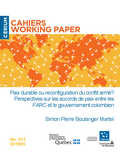Simon Pierre Boulanger Martel est candidat au doctorat en science politique à l’Université de Montréal.
Résumé
Le 23 juin 2016, le gouvernement colombien et les Forces armées révolutionnaires de Colombie (FARC) sont parvenus à un accord de paix à La Havane, à Cuba. Les accords, qui cherchent à mettre fin à plus de 50 ans de conflit armé, ont été contestés par certains secteurs de la société colombienne et ont connu un parcours tumultueux. Le texte de La Havane a été rejeté par la population lors d’un référendum le 2 octobre 2016. Le gouvernement et les FARC ont alors décidé de renégocier les accords, finalement ratifiés par le Congrès colombien. La guérilla a entamé le processus de désarmement, de démobilisation et de réintégration ainsi que sa transformation en parti politique légal. Mais les accords de paix ont subi un autre revers en 2018 lorsque Iván Duque, un opposant aux accords, a été élu président de Colombie. Le présent rapport pose la question : en quoi, malgré la polémique, les accords de La Havane constituent-ils une avancée pour la construction d’une paix durable en Colombie? Le rapport aborde cette question à travers l’analyse de trois dynamiques qui contribuent à la perpétuation du conflit armé : la puissance des FARC, la question agraire et la problématique des drogues illicites. En proposant des solutions concrètes aux problèmes sous-jacents au conflit armé, les accords de La Havane sont une étape importante dans la construction de la paix en Colombie. Néanmoins, certains développements post-accords témoignent des limites importantes et de la difficulté de leur mise en œuvre. Quoique les indicateurs en ce qui a trait à la violence dans le pays ont connu un déclin important depuis 2012, plusieurs problèmes persistent : la déroute électorale des FARC, l’incertitude en ce qui a trait à la mise en œuvre des réformes agraires sous Duque, la compétition entre guérillas et groupes criminels pour le contrôle territorial, les violences sociales, ainsi que l’augmentation de la production de la coca.
Abstract
On June 23, 2016, the Colombian government and the Revolutionary Armed Forces of Colombia (FARC) reached a peace agreement in Havana, Cuba. The accords, which seek to end more than 50 years of armed conflict, have been contested by certain sectors of the Colombian society. The peace deal was rejected by the population in a referendum on October 2nd 2016. The government and the FARC then decided to renegotiate the agreements, which were subsequently ratified by the Colombian Congress. The guerrilla group then began the disarmament, demobilization and reintegration process and transformed into a legal political party. The peace agreements experienced another setback in 2018 when Iván Duque, an opponent to the accords, was elected president. Given the controversy surrounding the process, do the Havana agreements constitute a step forward for the construction of a durable peace in Colombia? The report addresses this question through the analysis of three dynamics contributing to the resilience of the armed conflict, namely, the power of the FARC, the agrarian issue, and the problem of illicit drugs. By proposing concrete solutions to the problems at the root of the armed conflict, the Havana agreements are a potentially important step towards peace. Nevertheless, some post-agreement developments show significant limitations and underscore the difficulties surrounding their implementation. Although indicators of violence in the country have declined significantly since 2012, several problems persist. The electoral defeat of the FARC, the uncertainty regarding the implementation of the agricultural reforms under President Duque, the competition between guerrillas and criminal groups for territorial control, social violence, as well as the increase in the production of coca are all major challenges moving forward.
Télécharger le cahier en format PDF

